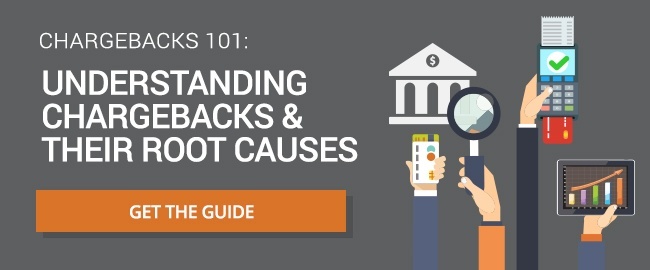Visa Compelling Evidence 3.0: What Merchants Need to Know
.png?width=50&height=50&name=navin_sequeira%20(2).png)
In an effort to keep up with the changing landscape of payments and fraud, credit card networks make frequent changes to the rules and policies governing the chargeback process. Most of these changes are relatively minor, but every once in a while they roll out a major update. The latest of these is Visa Compelling Evidence 3.0.
CE3.0 creates a new way for merchants to handle certain disputes that may prove valuable for those that can meet its requirements. Let's take a closer look at this update and discuss what effect it may have on merchants.
- Why Is Visa Updating Its Chargeback Rules?
- What Is Visa Compelling Evidence 3.0?
- How Will CE3.0 Work for Merchants?
- Conclusion
 It’s always important for merchants to be aware of card network rule updates. Staying in compliance with the rules can help you avoid liability for fraud and disputes. Ignoring the rules can leave you on the hook for fraudulent charges, get you saddled with expensive penalty fees, or even put your merchant account in jeopardy.
It’s always important for merchants to be aware of card network rule updates. Staying in compliance with the rules can help you avoid liability for fraud and disputes. Ignoring the rules can leave you on the hook for fraudulent charges, get you saddled with expensive penalty fees, or even put your merchant account in jeopardy.
E-commerce merchants should take particular interest in this latest update, as it outlines new standards for compelling evidence to fight false claims of fraud in card-not-present environments.
Why Is Visa Updating Its Chargeback Rules?
According to Visa’s data, the last few years have been good for card-not-present retailers—between 2019 and 2021, transaction volume has grown 51%. Unfortunately, disputes have been on the rise as well, growing 29% over the same time period—from just under 6 million disputes filed in 2019 to nearly 8 million in 2021.
Visa estimates that up to 80% of these are fraud disputes, with the other 20% falling under the more varied category of consumer disputes.
For Visa, focusing on fraud disputes serves two important purposes. First, it addresses the pain points of merchants who are dealing with rapidly increasing numbers of friendly fraud chargebacks. Second, by improving identification of false fraud claims, Visa can create more accurate fraud data models, leading to better authorization decisions, fraud prevention, and other benefits.
What Is Visa Compelling Evidence 3.0?
Visa Compelling Evidence 3.0 is a new way for merchants to fight illegitimate chargebacks by providing records of previous transactions to counter false claims of fraud.
Effective April 15, 2023, CE3.0 lays out a specific standard of evidence that, if met, is guaranteed to reverse or even prevent a chargeback under reason code 10.4: Fraud—Card-Absent Environment. The purpose of CE3.0 is to establish a clear and direct relationship between the merchant and the cardholder, proving beyond a reasonable doubt that the disputed transaction was made by the cardholder and not an unauthorized third party.
Under Visa’s previous chargeback rules, merchants could contest a reason code 10.4 chargeback by showing at least one transaction from any time period in which the IP address, email address, physical address, and telephone number match the details of the disputed transaction. For digital goods, two or more of the IP address, device ID, or email address would have to match. Visa intended for this to be sufficient evidence for the issuer to reverse the chargeback, but that was not always the case.
 If they saw a valid reason for doing so, the issuer could reject the representment and the acquirer (and by extension, the merchant) would remain liable for the chargeback.
If they saw a valid reason for doing so, the issuer could reject the representment and the acquirer (and by extension, the merchant) would remain liable for the chargeback.
Visa consulted with merchants and issuers to come up with the new criteria for contesting reason code 10.4 and proving that the cardholder participated in the transaction. CE3.0 requires merchants to provide records of two previous undisputed transactions using the same payment credentials that meet the following criteria:
- The transactions must be between 120 days and 365 days old as of the dispute date. Original credit transactions may be less than 120 days old.
- Either the IP address or the device ID/fingerprint must match across all three transactions.
- One additional element from the following list must also match across all three transactions: IP address, device ID/Fingerprint, user ID, or shipping address.
If the merchant can submit transaction data that meets all of the above criteria, the liability shifts to the issuer.
If CE3.0 is being used after a chargeback has occurred rather than through Order Insight, merchants will also need to provide evidence that the goods or services were delivered to the customer.
How Will CE3.0 Work for Merchants?
Merchants will be able to submit compelling evidence against fraud claims in the pre-dispute phase, when inquiries come in via Verifi’s Order Insight, or after a dispute has been filed and the chargeback can be looked up in Visa Resolve Online.
When a pre-dispute comes up in Order Insight, Visa will pre-select up to five transactions that are more than 120 days old and were never disputed or reported as fraud.
If you can provide the required matching data elements for two of those transactions, Verifi will review the data and stop the dispute from going forward and becoming a chargeback. The issuer will be responsible for resolving the cardholder’s dispute, and neither your chargeback rate nor your fraud rate will be affected.
However, this data must be provided through the Order Insight system within two seconds of the request. This means merchants must be able to automate these responses, and manual review is not an option.
If the dispute has already become a chargeback and you want to fight it through the representment process, you will need to work with your acquirer to select the qualified transactions with the matching data elements, complete the necessary forms, and submit your data to VROL. Provided the information provided is complete and accurate, the chargebacks will be reversed. The transaction will no longer count against your fraud ratio, but will still count against your dispute ratio.
Conclusion
While the new compelling evidence requirements are stricter in some ways, the liability shift back to the issuer is a big change that works in the merchant’s favor. It means that if you have the right evidence on your side, there’s no chance that the issuer will choose not to reverse the chargeback. By meeting the requirements of CE3.0, you can defend yourself from friendly fraudsters and reclaim even more of your revenue.
Thanks for following the Chargeback Gurus blog. Feel free to submit topic suggestions, questions, or requests for advice to: win@chargebackgurus.com


